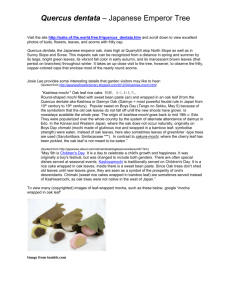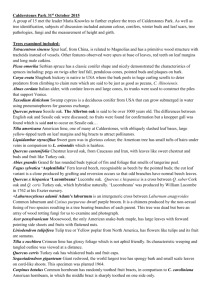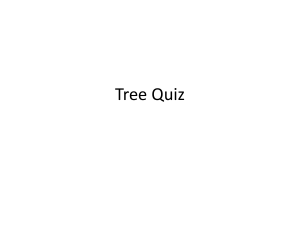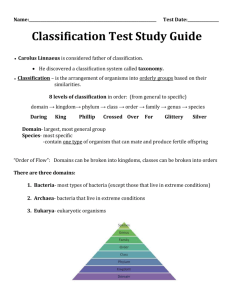Leaf Key - LSU AgCenter
advertisement
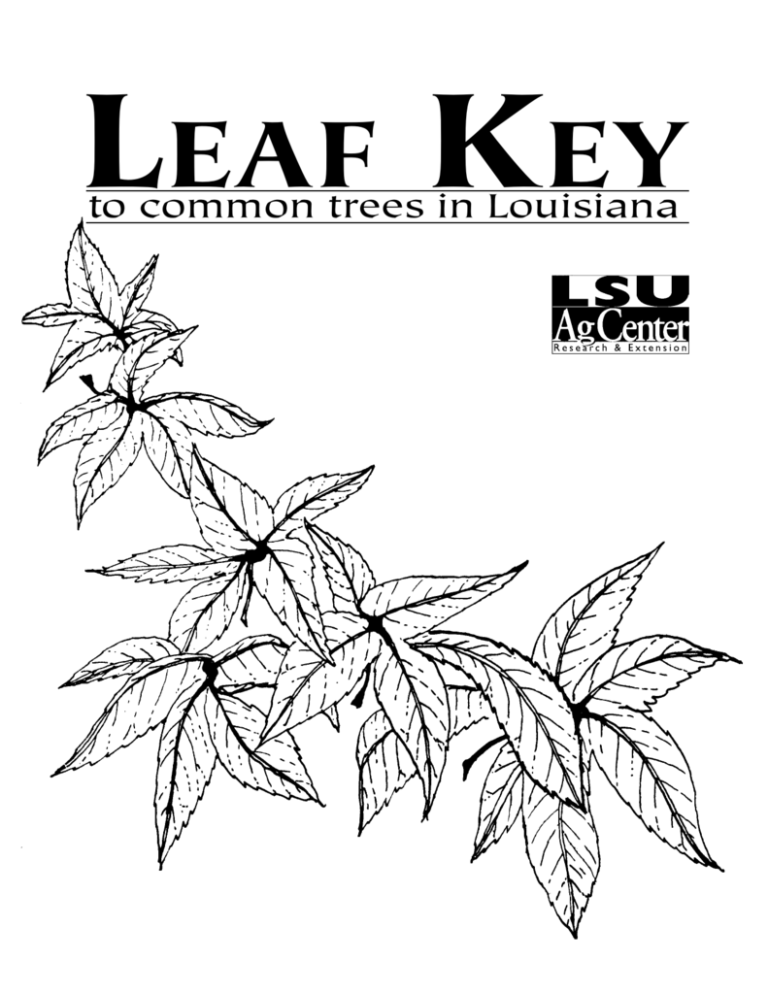
LEAF KEY to common trees in Louisiana 1 Why Do You Need to Learn to Identify Trees? Learning to identify trees can be fun. It’s an interesting hobby for people of all ages. You’ll gain an appreciation of nature through this hobby, and, in the addition, you will find that tree identification is basic to advanced studies in many fields, including forestry, botany, horticulture, wildlife, ecology and landscape architecture and environmental design. 2 Leaf Key to Common Trees in Louisiana How to Use the Leaf Key It is easy to identify the common trees of Louisiana with this guide. Long words have been left out and pictures are used to identify the leaves instead of written descriptions. Common trees include native and introduced trees from other parts of the United States or from foreign countries. You can identify most tree leaves if you follow these steps: 1. Read the description at each numbered heading in the key on page 4 and by process of elimination find the group to which the leaf of any unknown tree belongs. Diagrams of the leaf characters used in the key are show on page 5. 2. Turn to the picture numbers for this group. Leaf descriptions are repeated in the upper corner of the each page throughout the key. 3. Match the leaf with the picture it most closely resembles to find its name. Helpful Hints When you are collecting leaves, note and remember if the leaves are opposite or alternate on the twigs. Opposite leaves means that there will be leaves directly across from any leaf on the twig. Alternate leaves mean that there is no leaf directly across, but up and down the twig. Trees with alternate leaves also have alternate twigs and branches. Those with opposite leaves have opposite twigs and branches. Look carefully at several leaves and twigs or examine the branching habits of any tree to be identified. Frequently, a leaf, twig or branch may have died on an opposite leaved species, and the tree appears to be an alternate type. All leaves have a bud for next year’s growth at the base of the petiole or stem. A leaf in which there is only one blade is termed a simple leaf. Compound leaves have more than one blade on a common stalk, and each of these blades is called a leaflet or little leaf. Compound leaves do not have buds at the base of the leaflets. The leaves of all trees vary widely in size. Those on stump sprouts may often be three times larger than normal. Leaves will be smaller than usual during dry years. The illustrations have been drawn for the usual leaf sizes. You can see what the normal size is by examining the bracket at the side of each drawing. The bracket shows a one-inch scale. The leaves of all trees vary greatly in the form. No two leaves on any single tree are precisely alike. Those on the lower branches may be somewhat different than those higher in the tree. Leaves of black oak, in particular, are extremely variable in form and shape. In using this key, try to pick a leaf that appears average in size and form for each tree. Leaves of mulberry and sassafras trees may be either entire or lobed. Each is keyed out and illustrated under both headings. Oak and hickory trees hybridize readily and the offspring of these crosses are difficult to identify. Hybrids of willow oak and southern red oak, for example, will often have leaves typical of both parents and all variations between them on a single branch. The parents of such hybrids can sometimes be determined by using two or more leaves that repeatedly show the widest variation in form. A few Louisiana tree species have leaves almost alike. These will have an additional feature illustrated to aid in their identification. 3 Leaf Key Drawing Nos. (Pictures) I. Leaves broad; definitely not needle-like or scale-like, mostly deciduous A. Leaves alternate on the twigs 1. Leaves compound ................................................................................... 1-26 2. Leaves simple a. Leaf edge smooth .............................................................................. 27-51 b. Leaf edge toothed .............................................................................. 52-83 c. Leaves lobed...................................................................................... 84-104 B. Leaves opposite on the twigs 1. Leaves compound ................................................................................... 105-110 2. Leaves simple a. Leave edge smooth ............................................................................ 111-118 b. Leaf edge toothed .............................................................................. 119 c. Leaves lobed...................................................................................... 120-123 II. Leaves needle-like or scale-like; mostly evergreen A. Leaves needle-like ...................................................................................... 124-130 B. Leaves scale-like ......................................................................................... 131-132 4 Leaf Characters Bud Bud Opposite Alternate Bud Simple Compound Serrate Smooth Scale-like Dentate Toothed Single Doubly Compound Lobed Needle-like Bundles 5 Alternate, Compound 1. 4. Sapindus saponaria var. drummondii Western Soapberry Carya aquatica Water Hickory 6 *not native to North America 5. 2. 3. Ailanthus altissima* Tree-of-Heaven Carya X lecontei Bitter Pecan 6. Juglans nigra Black Walnut Carya illinoinensis Pecan Alternate, Compound 7. Carya myristici formis Nutmeg Hickory 10. Carya alba Mockernut Hickory 8. 11. Carya glabra var. hirsota Swamp Hickory Carya pallida Sand Hickory 9. 12. Carya texana Black Hickory Carya laciniosa Shellbark Hickory 7 Alternate, Compound 13. 16. 8 14. Carya cordiformis Bitternut Hickory Carya ovata Shagbark Hickory 17. Carya glabra Pignut Hickory Robinia pseudoacacia Black Locust 15. Carya X ludoviciana Louisiana Hickory 18. Gleditsia aquatica Water Locust Alternate, Compound 19. Gleditsia triacanthos Honey Locust (compound leaf) 21. Gleditsia X texana Texas Honey Locust 20. Gleditisia triacanthos Honey Locust (doubly compound leaf) 22. Acacia parnesiana Opopanax 9 Alternate, Compound 23. 25. 10 Zanthoxylum clava-herculis Prickly Ash (Hercules-Club) Erythrina crista-galli Crybaby Tree 24. Ptelea trifoliata Common Hoptree 26. Melia azedarach Chinaberry Alternate, Simple, Smooth 27. Magnolia macrophylla Bigleaf Magnolia 30. Magnolia virginiana Sweetbay Magnolia 28. 31. Magnolia pyramidata Cucumber Tree Cyrilla racemiflora Swamp Titi 29. 32. Magnolia grandiflora Southern Magnolia Sideroxylon lycioides Chittumwood 11 Alternate, Simple, Smooth 33. Morella cerifera Wax Myrtle 34. Quercus imbricaria Shingle Oak 35. Quercus phellos Willow Oak 37. Quercus virginiana Live Oak (obtusa leaves) (elliptical leaves) 36. 12 Quercus laurifolia Laurel Oak Alternate, Simple, Smooth 38. Cercis canadensis Redbud 39. Sideroxylon lanuginosum spp. lanuginosum Buckhorn 40. Frangula caroliniana Indian - Cherry (smooth stem) (hairy stem) 41. Persea borbonia Redbay (swamp bay) 13 Alternate, Simple, Smooth 42. Asimina triloba Pawpaw 45. 14 Sassafras albidum Sassafras 43. 44. Nyssa sylvatica Blackgum 46. Diospyros virginiana Persimmon Maclura pomifera Osage-Orange Alternate, Simple, Smooth 47. 50. Halesia diptera Silverbell Vaccinium arboreum Sparkleberry *not native to North America 48. Triadica sebifera* Chinese Tallowtree 49. 51. Cinnamomum camphora* Camphor-Tree Styrax grandifolia Snowbell 15 Alternate, Simple, Toothed 52. 55. Morus alba* White Mulberry Populus deltoides Eastern Cottonwood 16 *not native to North America 53. 56. Morus rubra Red Mulberry Populus heterophylla Swamp Cottonwood 54. Broussonetia papyrifera* Paper Mulberry 57. Nyssa aquatica Tupelogum Alternate, Simple, Toothed 58. Ulmus americana American Elm 61. Ulmus alata Winged Elm *not native to North America 59. Ulmus rubra Slippery Elm 62. Ulmus crassifolia Cedar Elm 60. Ulmus pumila* Chinese Elm (Siberian Elm) 63. Planera aquatica Water Elm 17 Alternate, Simple, Toothed 64. Tilia americana var. caroliniana Basswood 67. 18 Carpinus caroliniana Blue Beech 65. Hamamelis virginiana Witch Hazel 66. 68. Celtis laevigata Hackberry (sugarberry) Ostrya virginiana Hophornbeam Alternate, Simple, Toothed 69. 71. Betula nigra River Birch Castanea pumila Chinquapin 70. Fagus grandifolia American Beech 72. Symplocos tinctoria Horsesugar 19 Alternate, Simple, Toothed 73. 76. 20 Amelanchier arborea Service Berry (Shadbush) Prunus mexicana Mexican Plum 74. 77. Prunus serotina Black Cherry Prunus caroliniana Laurel Cherry 75. 78. Prunus umbellata Sloe Malus angustifolia Crap Apple Alternate, Simple, Toothed 79. Oxydendrum arboreum Sourwood 82. Ilex opaca American Holly 80. Salix nigra Black Willow 81. 83. Salix interior Sandbar Willow Ilex cassine Cassine (dahoon) 21 Alternate, Simple, Lobed 84. Quercus falcata Southern Red Oak 86. 22 Quercus velutina Black Oak 85. 87. Quercus pagoda Cherrybark Oak Quercus shumardii Shumard Oak Alternate, Simple, Lobed 88. Quercus buckleyi Nuttall Oak 89. (large trees) Quercus marilandica Blackjack Oak (Small trees) 90. Quercus nigra Water Oak 23 Alternate, Simple, Lobed 91. 93. 24 Quercus alba White Oak 92. Quercus macrocarpa Bur Oak Quercus stellata Post Oak 94. Quercus michauxii Cow Oak (Chestnut Oak) Alternate, Simple, Lobed 95. 98. Morus alba White Mulberry Sassafras albidum Sassafras 96. 99. Morus rubra Red Mulberry Liriodendron tulipifera Tuliptree 97. Broussonetia papyrifera Paper Mulberry 100. Platanus occidentalis Sycamore 25 Alternate, Simple, Lobed 101. Liquidambar styraciflua Sweetgum 103. Crataegus viridis Hog Haw (Green Haw) 26 102. Crataegus marshallii Parsley Hawthorne 104. Crataegus opaca May Haw Opposite, Compound 105. Fraxinus americana White Ash 108. Fraxinus profunda Pumpkin Ash 106. Acer negundo Box Elder 109. Fraxinus caroliniana Water Ash 107. Fraxinus pennsylvanica Green Ash 110. Fraxinus berlandieriana Evergreen Ash (Berlandier Ash) 27 Opposite, Simple, Smooth 111. Catalpa bignonioides Southern Catalpa 113. Cornus florida Flowering Dogwood 28 *not native to North America 112. Paulownia tomentosa* Paulownia 114. Cornus drummondii Roughleaf Dogwood Opposite, Simple, Smooth 115. Cornus foemina Bluefruited Dogwood (stiffcornel dogwood) 117. Chionanthus virginicus Fringetree 116. Osmanthus americanus Devilwood 118. Cephalanthus occidentalis Buttonbush 29 Opposite, Simple, Toothed 119. Viburnum rufidulum Rusty Blackhaw 30 Opposite, Simple, Lobed 120. Acer saccharinum Silver Maple 122. Acer rubrum var. drummondii Drummond Red Maple 121. Acer saccharum Sugar Maple 123. Acer rubrum Red Maple 31 Leaves Needle-like 32 124. Pinus taeda Loblolly Pine 125. Pinus palustris Longleaf Pine 126. Pinus elliottii Slash Pine 127. Pinus echinata Shortleaf Pine Leaves Needle-like 128. Pinus glabra Spruce Pine 129. Taxodium distichum Bald Cypress 130. Taxodium ascendens Pond Cypress 33 Leaves Scale-like (older tree) (young tree) 131. Juniperus virginiana Red Cedar 132. Chamaecyparis thyoides Southern White Cedar 34 Index Name Page No. American Beech ........................... 19 American Holly ............................ 21 Ash Evergreen (Beriandier) ............. 27 Green ....................................... 27 Prickly (Hercules Club) ............ 10 Pumpkin .................................. 27 Water ....................................... 27 White ....................................... 27 Bald Cypress ................................. 33 Basswood ..................................... 18 Birch, River .................................. 19 Blackhaw, Rusty ........................... 30 Blue Beech ................................... 18 Box Elder ..................................... 27 Buckthorn ..................................... 13 Buttonbush ................................... 29 Camphor Tree ............................... 15 Cassine (dahoon) .......................... 21 Catalpa, Southern .......................... 28 Cedar Red .......................................... 34 Southern White ........................ 34 Cherry .............................................. Black ....................................... 20 Indian ...................................... 13 Laurel ...................................... 20 Chinaberry .................................... 10 Chinese Tallowtree ........................ 15 Chinquapin ................................... 19 Chittumwood ................................ 11 Common Hoptree ......................... 10 Cottonwood Eastern ..................................... 16 Swamp ..................................... 16 Crab Apple.................................... 20 Crybaby Tree ................................ 10 Cucumber Tree ............................. 11 Cypress, Pond ............................... 33 Devilwood .................................... 29 Dogwood Bluefruited ............................... 29 Flowering ................................ 28 Roughleaf ................................ 28 Elm American ................................. 17 Cedar ....................................... 17 Chinese (Siberian) .................... 17 Slippery ................................... 17 Water Elm ................................ 17 Winged .................................... 17 Name Page No. Fringetree ..................................... 29 Gum Blackgum ................................ 14 Sweetgum ................................ 26 Tupelogum ............................... 16 Hackberry (Sugarberry) ............... 18 Haw Hog (Green Haw)..................... 26 May ......................................... 26 Hawthorne, Parsley ....................... 26 Hickory Bitternut ..................................... 8 Black ......................................... 7 Louisiana ................................... 8 Mockernut ................................. 7 Nutmeg ...................................... 7 Pignut ........................................ 8 Sand .......................................... 7 Shagbark .................................... 8 Shellbark.................................... 7 Swamp ....................................... 7 Water ......................................... 6 Hophornbeam ............................... 18 Horsesugar .................................... 19 Locust, Black .................................. 8 Locust, Honey (compound leaf) ...... 9 Locust, Honey (doubly compound leaf) ............. 9 Locust, Texas Honey ....................... 9 Locust, Water .................................. 8 Magnolia Bigleaf ..................................... 11 Southern .................................. 11 Sweetbay ................................. 11 Maple Drummond Red ....................... 31 Red .......................................... 31 Silver ....................................... 31 Sugar ....................................... 31 Mexican Plum ............................... 20 Mulberry Paper ................................. 16, 25 Red .................................... 16, 25 White ................................. 16, 25 Oak Black ....................................... 22 Blackjack ................................. 23 Bur .......................................... 24 Cherrybark ............................... 22 Cow ......................................... 24 Laurel (obtusa) ......................... 12 Name Page No. Live ......................................... 12 Nuttall ...................................... 23 Post .......................................... 24 Shingle .................................... 12 Shumard .................................. 22 Southern Red ........................... 22 Water ....................................... 23 White ....................................... 24 Willow ..................................... 12 Opopanax ....................................... 9 Osage-Orange ............................... 14 Pawlonia ....................................... 28 Pawpaw ........................................ 14 Pecan .............................................. 6 Pecan, Bitter ................................... 6 Persimmon .................................... 14 Pine Loblolly ................................... 32 Longleaf .................................. 32 Shortleaf .................................. 32 Slash ........................................ 32 Spruce ...................................... 33 Redbud ......................................... 13 Redbud (Swamp bay) .................... 13 Sassafrass ............................... 14, 25 Service Berry (Shadbush) .............. 20 Silverbell ...................................... 15 Sloe .............................................. 20 Snowbell ....................................... 15 Soapberry, Western ......................... 6 Sourwood ..................................... 21 Sparkleberry ................................. 15 Sycamore ...................................... 25 Titi ................................................ 11 Tree-of-Heaven ............................... 6 Tuliptree ....................................... 25 Walnut, Black ................................. 6 Wax Myrtle ................................... 12 Willow Black ....................................... 21 Sandbar .................................... 21 Witch Hazel .................................. 18 35 Acknowledgment Credit is given to Dr. Robert E. Noble (retired), LSU School of Forestry and Wildlife Management, for his technical assistance. The format for this publication is from a bulletin written by Robert L. Baker and Harry William Dengler of the Department of Horticulture, University of Maryland. Authors Hallie Dozier, Ph.D. (Forestry) Robert H. Mills, Ph.D. (Forestry) (retired) Louisiana State University Agricultural Center William B. Richardson, Chancellor Louisiana Agricultural Experiment Station David Boethel, Vice Chancellor and Director Louisiana Cooperative Extension Service Paul D. Coreil, Vice Chancellor and Director Pub. 1669 9/05 Rep. Issued in furtherance of Cooperative Extension work, Acts of Congress of May 8 and June 30, 1914, in cooperation with the United States Department of Agriculture. The Louisiana Cooperative Extension Service provides equal opportunities in programs and employment. 36



